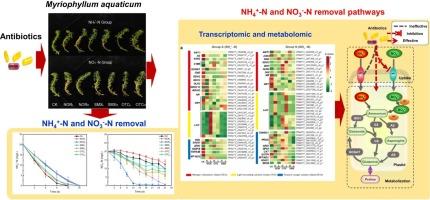Promote or inhibit? Transcriptomic and metabonomic insights into the effects of antibiotics on nitrogen uptake and metabolism in Myriophyllum aquaticum
IF 11.3
1区 环境科学与生态学
Q1 ENGINEERING, ENVIRONMENTAL
引用次数: 0
Abstract
Phytoremediation is an effective nitrogen removal method to alleviate eutrophication. However, the coexistence of antibiotics may inhibit nitrogen removal by aquatic macrophytes, and the underlying mechanisms remain unclear. Here, we systematically investigated the effects of three antibiotics (norfloxacin, NOR; sulfamethoxazole, SMX; and oxytetracycline, OTC) at environmental concentrations (1 μg/L and 1 mg/L) on ammonia (NH4+–N) and nitrate (NO3-–N) removal by the aquatic macrophyte Myriophyllum aquaticum. NOR, SMX, and OTC reduced NH4+–N removal by M. aquaticum by 10–36 %, with low levels (1 μg/L) of NOR reducing NO3-–N removal by up to 60 %. Antibiotics substantially reduced the biomass and chlorophyll contents but increased the antioxidant enzymes in M. aquaticum. While antibiotics inhibited NH4+–N removal, the promotion or inhibition effect of antibiotics on NO3-–N removal by M. aquaticum depended on types and levels of antibiotics. Transcriptomic and metabonomic profile analyses revealed differentially expressed genes and metabolites, suggesting that the mechanisms underlying the promotional/inhibitory effects of antibiotics on nitrogen uptake and metabolism were related to ammonia metabolism, the tricarboxylic acid cycle, photosynthesis, and oxidative stress. Myriophyllum aquaticum exhibited better NH4+–N removal than NO3-–N removal, as NH4+–N can be directly taken up by M. aquaticum and transformed into ammonium, while NO3-–N must be absorbed by the plant and then reduced to ammonium. During this process, antibiotics disrupt genes associated with nitrogen uptake and metabolism. In this study, we provide multiomics insights into the mechanisms of nitrogen metabolism in aquatic macrophytes affected by antibiotics and offers a scientific basis for water pollution control.

促进还是抑制?转录组学和代谢组学揭示抗生素对水生叶绿藻氮吸收和代谢的影响
植物修复是缓解富营养化的一种有效脱氮方法。然而,抗生素的共存可能会抑制水生大型藻类的脱氮作用,其潜在机制尚不清楚。在此,我们系统地研究了三种抗生素(诺氟沙星,NOR;磺胺甲噁唑,SMX;土霉素,OTC)在环境浓度(1 μg/L和1 mg/L)下对水生大型藻类水螅(Myriophyllum aquaticum)去除氨氮(NH4+-N)和硝氮(NO3--N)的影响。NOR、SMX 和 OTC 可使水生大型藻类对 NH4+-N 的去除率降低 10%-36%,其中低浓度(1 μg/L)的 NOR 可使 NO3-N 的去除率降低 60%。抗生素大大降低了水生藻类的生物量和叶绿素含量,但增加了抗氧化酶的含量。抗生素抑制了水生藻对NH4+-N的去除,而抗生素对水生藻去除NO3--N的促进或抑制作用则取决于抗生素的类型和水平。转录组学和代谢组学分析揭示了差异表达的基因和代谢产物,表明抗生素对氮吸收和代谢的促进/抑制作用的机制与氨代谢、三羧酸循环、光合作用和氧化应激有关。水生叶绿藻对NH4+-N的去除效果优于对NO3--N的去除效果,因为NH4+-N可直接被水生叶绿藻吸收并转化成铵,而NO3--N必须先被植物吸收,然后再还原成铵。在这一过程中,抗生素会破坏与氮吸收和代谢相关的基因。本研究从多组学角度揭示了水生大型藻类受抗生素影响的氮代谢机制,为水污染控制提供了科学依据。
本文章由计算机程序翻译,如有差异,请以英文原文为准。
求助全文
约1分钟内获得全文
求助全文
来源期刊

Journal of Hazardous Materials
工程技术-工程:环境
CiteScore
25.40
自引率
5.90%
发文量
3059
审稿时长
58 days
期刊介绍:
The Journal of Hazardous Materials serves as a global platform for promoting cutting-edge research in the field of Environmental Science and Engineering. Our publication features a wide range of articles, including full-length research papers, review articles, and perspectives, with the aim of enhancing our understanding of the dangers and risks associated with various materials concerning public health and the environment. It is important to note that the term "environmental contaminants" refers specifically to substances that pose hazardous effects through contamination, while excluding those that do not have such impacts on the environment or human health. Moreover, we emphasize the distinction between wastes and hazardous materials in order to provide further clarity on the scope of the journal. We have a keen interest in exploring specific compounds and microbial agents that have adverse effects on the environment.
 求助内容:
求助内容: 应助结果提醒方式:
应助结果提醒方式:


